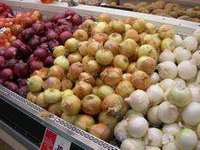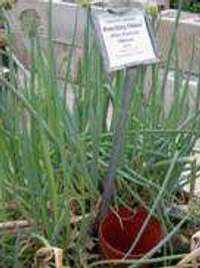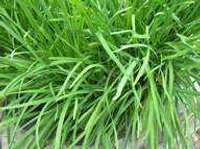INTRODUCTION

Photo by Larry Yarger
A case could be made that onions are one of two universal vegetables that are cherished in almost every culture, tomatoes being the other. Both are difficult to grow in many tropical and subtropical climates. Where a vegetable is both popular and difficult to grow, it brings a good price. If a way can be found to grow that crop, both local farmers and consumers benefit. While attending a horticulture conference in Honduras, Scott Sherman and I had an opportunity to visit with onion specialist and international consultant, Dr. Lesley Currah. She travels the world working with onion researchers. The interview follows.
Natural Resources Institute
Q. Tell us more about the Natural Resources Institute where you work.
A. The NRI is an agency of the British government, the Overseas Development Administration. Their purpose is to use science and technology to help people in poorer [less-developed] countries develop using their own natural resources. Help is offered to any country eligible to receive British aid.
Q. What is your assignment?
A. I work in the fruit, vegetable and root section. My current assignment is an evaluation of onion production and storage in low latitudes. A particular interest is to expand onion production in very wet climates and on islands at sea level. Our approach is fourfold. (1) We are promoting a network of contacts on onions in the tropics through a newsletter called Onion Newsletter for the Tropics. [Published 1989-1996, Ed.] (2) We evaluate onion varieties through trials done by collaborators around the world. (3) We provide training in how to do a trial and interpret the results. (4) We maintain a gene bank of interesting onion accessions.
Onions and Day Length Sensitivity

Welsh or Bunching Onion Allium fistulosu. Photo by Larry Yarger
Q. Often a development worker from a temperate climate will plant onion seed from home only to find that it only makes "little green onions," no bulbs. Explain what is happening.
A. Onions are very sensitive to day length. The kind of onion that is grown in the higher latitudes requires long day length to form bulbs. When onions are grown during short days it is important to plant what are called "short day onions."
Q. Is there a sharp border between long and short day varieties or are there degrees of short-day-ness?
A. There are several intermediate degrees, which would be common in places like north Texas or Spain. A well organized seed catalog will not just say whether onions are "short" or "long" day varieties. They will organize them under day lengths, e.g. 11-13 hour, 12-14 hour etc. Some varieties like Beth Alpha in Israel go to less than 12 hours. These mature around Christmas. However, because the quality of onions harvested at mid winter is often inferior, e. g. with more double bulbs, farmers usually want onions to mature as days begin to lengthen but before the rains have started.
Q. What does happen if you plant a long day onion near the equator?
A. As you said, they grow into little green onions. They may thicken a little at the base. They may actually be preferable for producing little green onions because the short day types might begin forming bulbs too soon.
Onion Sets

Allium cepa Photo by Larry Yarger
Q. Do onion sets exist for short day onions?
A. Many in the tropics use the set system to get onions going near the end of the rainy season in order to extend the onion harvest forward in time. Probably 30% of the onions in Bangladesh are grown that way. Sets are commercially available in Zimbabwe. However, the quality of onions grown from sets can be inferior, for example with more double bulbs.
Q. How would a farmer make his/her own sets?
A. Just as the hot season is starting, sow seeds at a very close spacing. Do not thin the onions. Harvest at ½ inch (1.25 cm) diameter or else they will bolt. If they are sufficiently crowded and if it is well past the day length where the variety would normally bulb, they will die down naturally. It may take a few seasons of trial and error to get it right. Keep the sets in an airy, warm place, for example, just under the rafters.
Saving Onion Seed
Q. Under what conditions might a farmer be able to save his/her own onion seed?
A. This is difficult. You need a variety that will easily bolt (send up a flower stalk) the second year. You do not want any variety that bolts the first year because that trait would create havoc in your harvest. Select bulbs from the best onions and store until the next season. Timing then becomes important. If you plant too soon while daily temperatures are increasing they may go into bulbing mode and split rather than flower. Wait to plant the bulbs until the average daily temperatures have started decreasing. The stalk gets a lot of diseases so, unless it is very dry, you may need to spray a lot.
Onion Variety Trials
Q. What do you look for in a variety trial?
A. You would want most varieties in your trial to be acceptable to local people. If onions are eaten raw, you want varieties which are mild; if cooked, pungent onions that store well. The pungency, by the way, depends not only on the variety of onion but also on how much sulfur is in the soil. You would want to look for onions where a high percentage of the harvested bulbs are marketable and where the bulbs store well. Even the shape and color may affect marketability and price.
Onion Storage in the Tropics
Q. How should onions be stored?
A. We are writing a bulletin on storing onions in the tropics. The humidity should be about 75% and the temperature 25-30°C. If the temperatures drop much below 18°C the onions may begin to sprout. For example, in Zimbabwe we found that stored onions began sprouting when evening temperatures dropped to 15°C. This is somewhat dependent upon variety, but only to a limited degree. Light is not a very important factor. Light may cause some fading of red onions on the surface only. Light can also cause some green color to develop in white onions.

Chinese or Garlic Chives. Allium tuberosum. Photo by Larry Yarger
Q. Do short day onions store reasonably well?
A. Yes, but there is room for improvement. The Israeli's have been working to select grano and granex types that will store for a long time. The factors they select for are ability of the bulb to go into a good dormant period and qualities in the skin that will protect the bulb. Their varieties are being tested all over the tropics.
“Grano” vs. “Granex” Onions
Q. I notice a lot of short day onions named "grano" or "granex," followed by a number. What are these?
A. Texas Grano onions came from onions in Spain which over-winter well in the field, but have poor storage characteristics in general. The granex series is hybrid, the grano open pollinated (non-hybrid).
More on Saving Onion Seed and Onion Pollination
Q. This brings up an important question. If you are working where it is possible to produce your own onion seed, would it be a big mistake to save seed from a hybrid onion?
A. No, if you are prepared to do a little selection, and if the hybrid is much better than the locally available varieties, you might end up ahead. For example, in India the Pusa Ratnar variety came from the red granex hybrid. You might have some problems with male sterility in early generations.
Q. How are onions pollinated?
A. Onion pollen is sticky, so there is not much wind pollination. They are pollinated by insects, such as honeybees. Some seed producers throw dead chickens in the field to attract blow flies. Some crawling insects are also pollinators.
Q. Some of the special seeds that ECHO distributes have come from members of our overseas network. Is there any way in which they might help you?
A. I am interested in any traditionally maintained, locally grown onion. However, the needs of our seed bank require that we obtain about 50 g of any new accession. England is so far north that we are unable to increase the seed ourselves. If someone has an onion that might be of interest, they should first write and tell me as much about it as they can, and why they value the onion. My address is: Lesley Currah, Horticulture Research International, Wellesbourne, Warwick, CV35 9EF, United Kingdom.
Additional Insight from Dr. Currah
The following selection is a quotation from, Onions in the Tropics: cultivars and country reports, written by Dr. Currah, and included in the book, Allium Crop Science: Recent Advances (2002), of which Dr. Currah is editor.
http://www.cabi.org/pdf/books/9780851995106/9780851995106.pdf
“All onions are physiologically ‘long-day’ plants, but the mechanism that controls onion bulbing is really a phytochemical response to the length of the night. Therefore, in the so-called ‘short-day’ onions that are grown in the tropics, bulbing is in fact induced in response to night lengths, which are relatively long, at around 12 hours. Intermediate-day (ID) and long-day (LD) cultivars grown at higher latitudes are induced to form bulbs by nights that are relatively shorter (i.e. nights of 11-8 hours, corresponding to days of 13-16 hours). I will use the convention of referring to ‘short-day onions here.
“Most onions grown in the tropics are of the short-day (SD) type, but many different kinds of SD onion exist (Currah and Proctor, 1990). One way to classify them is by the amount of homogeneity which the populations have attained through selection and breeding: from the most genetically varied, the landraces, through OP cultivars to the most advanced hybrids. In the tropics, a complete range of these stages can be found.”
Useful Publications and References to Dr. Currah’s Works
Brewster, J.L. 1994. Onions and other Vegetable Alliums. Wallingford, Oxon, UK: CAB International.
Brice, J., L. Currah, A. Malins and R. Bancroft. 1997. Onion Storage in the Tropics: A Practical Guide to Methods of Storage and their Selection. Chatham, UK: Natural Resources Institute.
Currah, L. 2002. Onions in the Tropics: Cultivars and Country Reports. In Allium Crop Science: Recent advances, ed. H.D. Rabinowitch and L. Currah, 379-408. Wallingford, Oxon, UK: CABI Publishing; New York, NY, USA: CABI Publishing.
Currah, L. 1981. Onion Flowering and Seed Production. Scientific Horticulture 32:24-46.
Currah, L. 1985. Review of Three Onion Improvement Schemes in the Tropics. Tropical Agriculture (Trinidad) 62:131-136.
Currah, L. 1986. Leek Breeding: a Review. Journal of Horticultural Science 61:407-415.
Currah, L. 1990. Pollination Biology. In Onions and Allied Crops, Vol 1, ed. H.D. Rabinowitch and J.L. Brewster, 135-149. Boca Raton, FL, USA, CRC Press.
Currah, L. and D.J. Ockenden. 1978. Protandry and the Sequence of Flower Opening in the Onion (Allium cepa L.). New Phytologist 81:419-428.
Currah, L. and D.J. Ockenden. 1983. Onion Pollination by Blowflies and Honeybees in Large Cages. Annals of Applied Biology 103:497-506.
Currah, L. and E.B. Peffley. 1988. Chromosomal Location of Adh-1 and Pgm-1 in Allium fistulosum. Theoretical and Applied Genetics 75:945-949.
Currah, L. and F.J. Proctor (eds). 1992. Onion Newsletter for the Tropics. Chatham, UK: Natural Resources Institute.
Currah, L. and F.J. Proctor. 1990. Onions in the Tropical Regions. Bulletin 35. Chatham, UK: Natural Resources Institute.
Currah, L. and R.B. Maude. 1984. Laboratory Tests for Leaf Resistance to Botrytis squamosa in Onions. Annals of Applied Biology 105:277-283.
Mortensen, E. and E.T. Bullard. 1970. Handbook of Tropical and Subtropical Horticulture, 98-99. Washington, D.C.: Department of State, Agency for International Development [USAID].
Pest Control in Tropical Onions. 1986. London: Tropical Development and Research Institute [TDRI]
Thompson, A.K. 1982. the Storage and Handling of Onions. London: Tropical Products Institute.
Cite this article as:
Price, M.L. 1992. Onions in the Tropics and Subtropics. ECHO Technical Note no. 24.